Parenting Hacks: Building Strong Bonds with Your Children

Welcome to the world of "Parenting Hacks: Building Strong Bonds with Your Children"! 🚀 In this blog post, we'll explore eight powerful strategies that can transform your relationship with your little ones.
In the whirlwind of school runs, homework, and bedtime routines, parents often pause and wonder how to truly connect with their children on a deeper level. Amidst the daily demands, nurturing that special bond can feel like another item on an already overflowing to-do list. This isn't about quick fixes or superficial shortcuts, but about powerful, research-backed 'hacks' – simple yet profound ways to weave connection into the fabric of family life. The term "hack" here refers to smart, effective strategies rooted in child psychology, designed to make every interaction count towards building a stronger, more resilient relationship with your child. This bond is the cornerstone of their well-being, shaping their present happiness and future success. For more insights into purposeful parenting, see our guide on(parenting with purpose ). The desire for such strategies often stems from the modern parenting challenge of feeling time-pressured, seeking efficient ways to be effective. These "hacks" are about applying psychological principles smartly to enhance the quality and impact of interactions, making them more meaningful in fostering genuine bonds.
Why Strong Bonds Aren't Just "Nice-to-Have"—They're Essential
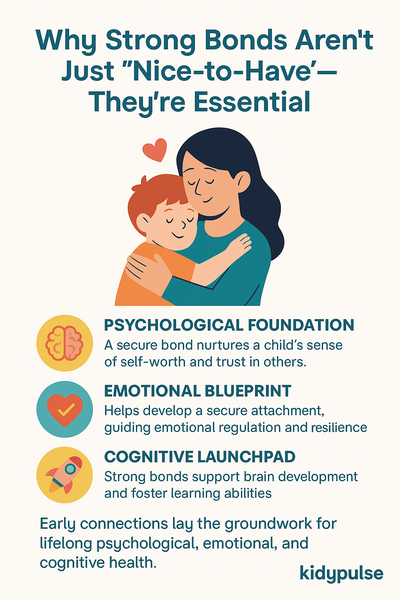
The connection between a parent and child is far more than a source of warm feelings; it's a fundamental force in a child's development, a topic we explore further in our child development milestones guide. These early bonding moments are like the architects of a child's brain. Every hug, every responsive word, every shared laugh helps build crucial neural pathways. Scientific understanding reveals that these early connections actively sculpt the developing brain, laying the groundwork for lifelong emotional, psychological, and cognitive health.
- The Psychological Foundation: A secure bond forms the bedrock for a child's sense of self, their belief in their own worth, and their ability to trust others. When a child feels consistently loved and supported, they internalize a message: "You are safe, you are valued, you matter." This message becomes an inner voice that shapes their self-esteem and confidence as they grow. The quality of parent-child relationships during these formative years can significantly shape a child's emotional resilience and their capacity for forming healthy relationships later in life.
- The Emotional Blueprint: Consistent love, care, and responsiveness from a parent help a child develop what psychologists call a secure attachment style. This emotional security acts like a compass, guiding them through life's inevitable storms and uncertainties. It helps them regulate their feelings, understand the emotions of others, and bounce back from challenges. Secure attachments are an important protective factor for mental health, influencing social and emotional development, as well as the ability to learn.
- The Cognitive Launchpad: The impact of strong bonds extends deeply into cognitive development. Responsive parenting and interactive relationships stimulate a child's brain, enhancing cognitive abilities such as language development, problem-solving skills, and the ability to regulate emotions. The conversations, storytelling, and reading that often occur in close parent-child relationships play a significant role in expanding a child's vocabulary and comprehension, contributing to early education success. Children who feel secure are more likely to be curious, explore their environment, and engage confidently in learning.
Understanding the foundational nature of these bonds can shift parenting from a primarily reactive, problem-solving mode to a proactive, foundation-building one. Strengthening this connection is not just for feeling good in the moment; it's a critical investment in preventing future difficulties by fostering resilience, self-regulation, and intrinsic security. The impact is tangible, with loving interactions physically shaping brain development and hormonal systems, such as the release of oxytocin, the "love hormone," during bonding moments. This can be incredibly validating for parents, showing the profound, physical impact of their relational efforts. Furthermore, the psychological, emotional, and cognitive benefits are not isolated but deeply interconnected, with the bond acting as the central hub. A child who feels emotionally secure is more likely to explore and learn, developing a positive sense of self, demonstrating that working on the bond has ripple effects across all areas of development.
The "Secret Sauce": Core Ingredients for a Thriving Connection
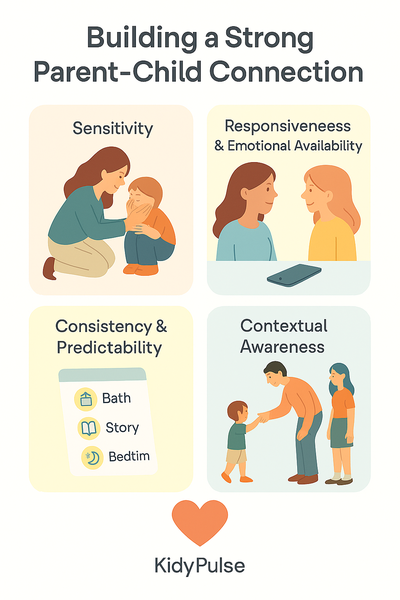
Building a strong parent-child bond isn't about a secret formula, but rather about consistently incorporating key relational ingredients into daily interactions. These elements, when present, create an environment where connection can flourish.
- Ingredient 1: Sensitivity – Tuning In to Your Child's Unique Channel. Sensitivity involves accurately perceiving and interpreting a child's signals—both verbal and non-verbal—and responding appropriately to their needs for comfort, protection, or engagement. It's about understanding their specific needs in that particular moment, rather than applying a one-size-fits-all response. A caregiver's correct interpretations of their child's signals and subsequent appropriate responses are at the core of providing psychological security. For instance, noticing a child's slight hesitation before entering a new social situation and offering a quick, reassuring smile or touch, versus dismissing their subtle cue of anxiety, demonstrates sensitivity. This attunement, a core aspect of mindful parenting, makes a child feel understood and validated.
- Ingredient 2: Responsiveness & Emotional Availability – Being There, Truly There. Responsiveness is the prompt and contingent reply to a child's needs and their bids for connection. Being attuned to a child's needs and responding promptly promotes a sense of security. Emotional availability, a crucial partner to responsiveness, means not just being physically present but also mentally and emotionally engaged. It involves acknowledging and validating a child's feelings and offering comfort when needed. This contrasts sharply with being physically in the same room but distracted by a phone or other tasks. True emotional availability communicates to a child that their inner world matters.
- Ingredient 3: Consistency & Predictability – Creating a Safe Harbor. Children thrive on knowing they can reliably depend on their caregivers. Consistent responses to their needs build trust and a profound sense of security. A child who experiences love, care, and consistency in their early relationships is more likely to develop a secure attachment style. This doesn't mean parents must be robotic or react identically every time, but rather that the child generally knows what to expect from their parent's care and emotional support. Predictability and routine, such as consistent bedtime routines, also provide a sense of stability for children, making their world feel safer and more manageable.
- Ingredient 4: Contextual Awareness – Adapting to a Changing Landscape. Effective parenting requires adapting responses based on the child's developmental stage and the specific situation or environment. What comforts a toddler might be perceived differently by a teenager, and a response appropriate at home might need adjustment in a public setting. Parenting responses required in one context may be insensitive in another. This highlights the necessity for parental flexibility, attunement, and an understanding of their child's evolving needs across time.
These core ingredients are not isolated; they work synergistically. Sensitivity informs responsiveness, and when responsiveness is consistent, it builds trust more effectively. Emotional availability underpins the quality of both sensitivity and responsiveness. Contextual awareness then guides how these ingredients are applied effectively. It's also vital for parents to understand that the goal is not perfection but "good enough" attunement. Striving for a balance "on the whole" ensures children know they will be protected and comforted. Occasional misattunements are normal and, when repaired, can even strengthen resilience. This understanding can alleviate parental guilt and encourage persistence. Finally, being sensitive, emotionally available, and responsive requires a degree of parental self-awareness and emotional regulation. Managing one's own stress and emotional triggers is crucial for being truly present for a child.
Your Go-To Guide: Parenting Hacks for an Unbreakable Bond
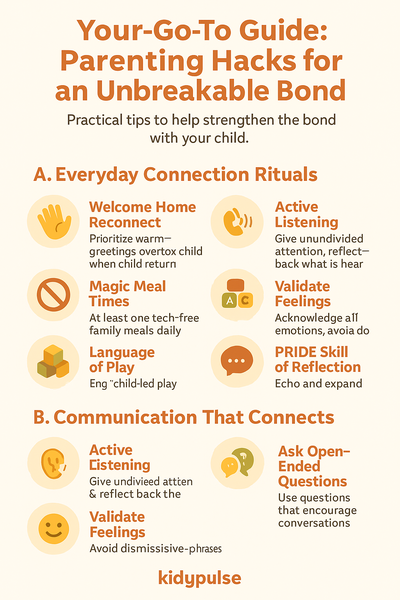
These "hacks" are practical, actionable strategies designed to weave connection into the tapestry of daily life, and you can find more parents tips on our blog. They are most effective when delivered with genuine presence and warmth, because the emotional quality behind an action is often more impactful than the action itself. Remember, cherishing life's little moments and small, consistent efforts compound over time, building a strong and resilient bond. Many of these are learnable skills, empowering parents to enhance their connection, even if it doesn't come naturally or wasn't part of their own upbringing.
A. Everyday Connection Rituals: Weaving Love into Daily Life
- Hack: The "Welcome Home" Reconnect:
- Instead of immediately diving into questions about homework or chores when a child (or the parent) arrives home, dedicate the first few minutes to a warm, genuine greeting. Make eye contact, smile, offer a hug, or simply express happiness to see them.
- Why it works: This small ritual signals to the child that they are a priority and that the connection is valued, setting a positive tone for the rest of the interaction. It creates a moment of emotional refueling.
- Hack: Magic Meal Times (No Phones Allowed!):
- Make at least one meal a day a tech-free zone where the family connects. Explore the power of family meals and encourage everyone to share a highlight or a challenge from their day. Consider balancing screen time and mealtime for a healthier family dynamic.
- Why it works: Shared meals provide consistent, predictable opportunities for conversation and strengthen family identity and belonging.
- Hack: Bedtime Bond-Builders:
- Establish a calming bedtime routine that includes moments for connection, like reading a story, sharing quiet talk about the day, or a special cuddle. The importance of sleep for children's health cannot be overstated.
- Why it works: Bedtime can be a vulnerable time for children. Consistent, loving routines provide security and a peaceful end to the day, reinforcing the feeling of being loved and safe.
- Hack: The Language of Play – Your Child's Native Tongue:
- Dedicate even 10-15 minutes of child-led, distraction-free play. Get on the floor, follow their lead, and enter their world. Explore ideas for outdoor play and child development or fun brain-boosting activities. Don't forget to choose age-appropriate toys.
- Why it works: Play is how children process emotions, learn social skills, and connect. Joining them in their play shows value for what's important to them and strengthens the bond through shared joy.
- Hack: One-on-One "Special Time":
- If there is more than one child in the family, try to carve out brief, regular one-on-one time with each. It doesn’t have to be elaborate – a quick walk, a special handshake, or 10 minutes of dedicated chat.
- Why it works: Individual attention makes each child feel uniquely seen, understood, and cherished, which is crucial for their self-worth.
B. Communication That Connects: Really Hearing Your Child
- Hack: Active Listening – Beyond Just Hearing Words:
- When a child talks, put down the phone, turn off the TV, make eye contact, and truly listen. Reflect back what is heard them saying and feeling ("It sounds like you were really frustrated when...").
- Why it works: Active listening validates the child's experience, shows care, and encourages them to open up more.
- Hack: Validate Their Big (and Little) Feelings:
- Acknowledge and accept all of a child's emotions, even if they seem irrational or inconvenient. Instead of saying "Don't cry" or "It's not a big deal," try "I see you're feeling really sad/angry right now". Learning to transform toddler tantrums involves validating their feelings.
- Why it works: Validation teaches children that their emotions are acceptable and manageable, fostering emotional intelligence and trust in the parent as a safe person to share with.
- Hack: The "PRIDE" Skill of Reflection – Echo and Expand:
- Gently repeat or paraphrase what the child says, sometimes adding a little more to it. If they say, "Doggy run!" one can say, "Yes, the doggy is running fast!".
- Why it works: This shows engagement, helps them feel heard, encourages more conversation, and subtly supports language development.
- Hack: The "PRIDE" Skill of Description – Be Their Sportscaster:
- Narrate what the child is doing in a non-judgmental way: "You're stacking those blocks so carefully," or "You're concentrating hard on your drawing".
- Why it works: This shows interest, boosts their self-esteem by acknowledging their efforts, and can help increase their attention span.
- Hack: Ask Open-Ended "Door Opener" Questions:
- Instead of questions with a yes/no answer ("Did you have a good day?"), try questions that invite more detail: "What was the most interesting thing that happened today?" or "Who did you play with at recess and what did you do?".
- Why it works: Open-ended questions encourage more elaborate responses, giving more insight into their world and fostering deeper conversations.
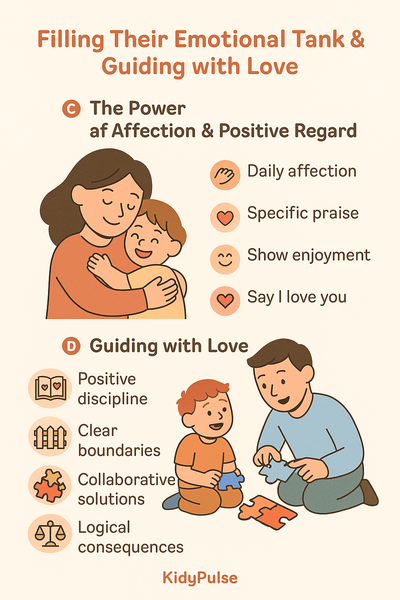
C. The Power of Affection & Positive Regard: Filling Their Emotional Tank
- Hack: The "Daily Dose" of Warm Affection:
- Make physical affection a regular part of the day – hugs, cuddles, a reassuring hand on the shoulder.
- Why it works: Physical touch releases oxytocin (the "love hormone"), reduces stress, and communicates love and security in a powerful, non-verbal way. Hugging can help children learn to regulate their emotions and manage stress.
- Hack: Specific, Genuine Praise – Catch Them Being Good:
- Instead of a generic "Good job!", label the praise: "I really appreciate how patiently you waited while I was on the phone," or "You worked so hard on that puzzle, even when it got tricky!" Focus on effort and specific behaviors.
- Why it works: Specific praise reinforces positive behaviors, builds self-esteem by highlighting their capabilities, and shows attention to their efforts.
- Hack: The "PRIDE" Skill of Enjoyment – Show Your Delight:
- Let facial expressions and voice show genuine warmth, enthusiasm, and enjoyment when interacting with the child. Smile, laugh together, use an animated tone.
- Why it works: This communicates genuine enjoyment of their company, which strengthens the bond and makes them feel loved and valued.
- Hack: Say "I Love You" Often and Unconditionally:
- Tell the child "I love you" every day, especially during difficult moments or after a disagreement.
- Why it works: Verbal affirmations of love reinforce their sense of security and belonging, assuring them that parental love isn't dependent on their behavior.
D. Guiding with Love: Discipline That Strengthens, Not Strains
- Hack: Shift from Punishment to Positive Discipline:
- Focus on teaching self-control and responsibility rather than on punitive measures that instill fear. The Latin origin of "discipline" is 'to teach'. Positive discipline aims to build trust and understanding. Explore positive discipline strategies and understand why positive parenting is effective.
- Why it works: Positive discipline builds trust and understanding, whereas punitive methods can damage the parent-child relationship and a child's self-esteem.
- Hack: Set Clear, Consistent, Respectful Boundaries:
- Establish age-appropriate rules and expectations, and explain the reasons behind them. Apply consequences consistently and calmly. Understanding different parenting styles can help in setting these boundaries.
- Why it works: Clear boundaries provide a sense of security and predictability, helping children understand what's expected and learn self-regulation. Respectful enforcement maintains the bond.
- Hack: Collaborative Problem-Solving:
- When misbehavior occurs, engage the child in a dialogue (once calm) to understand their perspective and involve them in finding solutions. "What happened? What could we do differently next time?".
- Why it works: This approach teaches valuable life skills, strengthens their sense of autonomy, and shows respect for their ability to contribute to solutions, fostering cooperation.
- Hack: Use "Logical Consequences":
- Ensure consequences are related to the behavior. If they make a mess, they help clean it up. If they misuse a toy, they lose access to it for a short time.
- Why it works: Logical consequences help children understand the direct impact of their actions and learn responsibility without feeling arbitrarily punished.
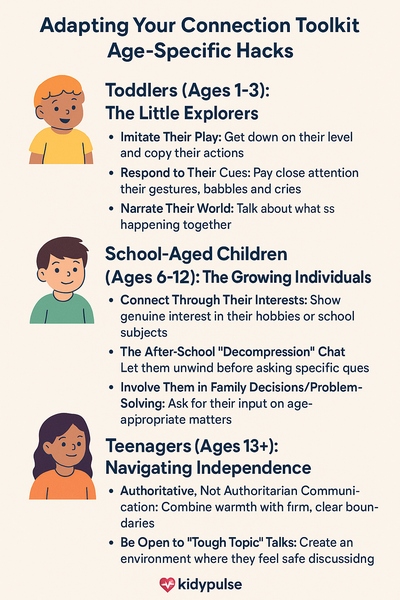
E. Adapting Your Connection Toolkit: Age-Specific Hacks
- Toddlers (Ages 1-3): The Little Explorers
- Hack: Imitate Their Play (PRIDE Skill): Get down on their level and copy their actions during play. If they bang a drum, the parent bangs a drum. Why: Shows interest, makes them feel important, teaches social turn-taking. For more on this stage, see our guide to navigating the preschool years.
- Hack: Respond to Their Cues: Pay close attention to their gestures, babbles, and cries, responding appropriately with comfort, words, or actions. Why: Builds trust and security, supports communication development.
- Hack: Narrate Their World: Talk about what is happening together, what they see, and what they're experiencing. "Look at the big red ball! You're pushing it!". Why: Builds vocabulary, shows engagement, helps them make sense of their environment.
- School-Aged Children (Ages 6-12): The Growing Individuals
- Hack: Connect Through Their Interests: Show genuine interest in their hobbies, favorite games, or school subjects. Ask questions, learn alongside them. This could involve eco-friendly crafts or discussing how to foster creativity.
- Why: Shows value for what's important to them, creates shared experiences.
- Hack: The After-School "Decompression" Chat: Don't bombard them with questions immediately. Let them unwind, then find a relaxed moment to ask specific, positive questions about their day. Why: Respects their need for downtime, makes them more likely to share.
- Hack: Involve Them in Family Decisions/Problem-Solving: Ask for their input on age-appropriate family matters, like planning a weekend activity or solving a simple household issue. Why: Builds their sense of competence and belonging, teaches responsibility.
- Teenagers (Ages 13+): Navigating Independence
- Hack: Authoritative, Not Authoritarian Communication: Combine warmth with firm, clear boundaries. Listen to their perspective even if there is disagreement, and explain the reasoning. Learn about meaningful conversations with your teen.
- Why: Fosters respect and cooperation, supports their developing autonomy while maintaining safety.
- Hack: Be Open to "Tough Topic" Talks: Create an environment where they feel safe discussing sensitive issues like dating, peer pressure, or online safety, without fear of immediate judgment. This includes personal safety education.
- Why: Keeps lines of communication open, allows for guidance and support.
- Hack: Respect Their Need for Privacy & Autonomy (Balanced with Monitoring): As they mature, allow for more independence and privacy, while still maintaining appropriate, sensitive supervision. Why: Shows trust, supports their individuation, but ensures safety.
The Lifelong Rewards: Why Investing in Your Bond Pays Off Big Time
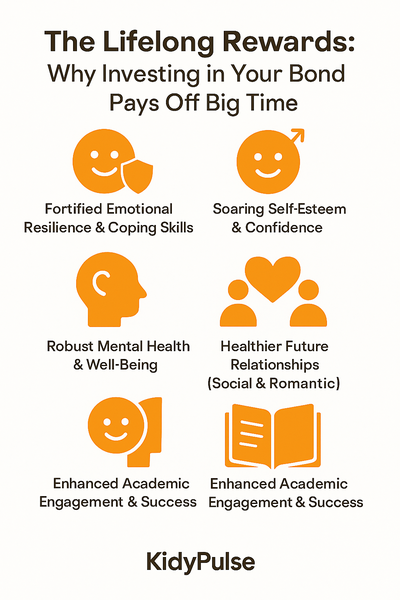
Investing time and effort into building a strong parent-child bond yields profound and lasting benefits that extend far beyond childhood, shaping an individual's emotional landscape, self-perception, and ability to navigate the complexities of life. Explore more about healthy parenting on our blog.
- Benefit 1: Fortified Emotional Resilience & Coping Skills: Children who grow up with secure parental bonds are better equipped to handle life's stresses, disappointments, and challenges. This bond provides an invisible shield; when life throws curveballs, these children can manage their emotions more effectively, cope with setbacks, and bounce back with greater ease. This emotional foundation helps them manage stress and develop resilience during difficult times. Resilience isn't an innate trait but is actively fostered by the consistent availability of a secure base; the bond teaches coping through repeated experiences of having distress soothed and support provided.
- Benefit 2: Soaring Self-Esteem & Confidence: Feeling unconditionally loved, valued, and understood by parents is fundamental to building a strong sense of self-worth. When children know they are deeply loved and accepted for who they are, they develop robust self-esteem that allows them to face the world with confidence. This self-worth isn't primarily built through achievements alone, but through the relational experience of being seen, heard, and valued by significant caregivers.
- Benefit 3: Robust Mental Health & Well-being: Secure attachment acts as a powerful protective factor against various mental health challenges. A strong bond is linked to a lower risk of anxiety, depression, and other mental health issues throughout life. It acts as a buffer against stress, promoting healthier coping mechanisms.
- Benefit 4: Healthier Future Relationships (Social & Romantic): The early parent-child relationship serves as an internal working model, a blueprint for future relationships. Securely attached children are more likely to form healthy, trusting, and intimate relationships as adults because the love and trust they experience becomes their internal guide for what healthy connections look and feel like. This often translates to being self-confident, hopeful, and able to healthily manage conflict and respond to intimacy in adulthood.
- Benefit 5: Enhanced Academic Engagement & Success: A secure emotional foundation frees up a child's mental energy to explore, learn, and engage at school. Children who feel secure and supported are often more curious, persistent, and successful learners. They are more likely to enjoy school and ask for help when needed.
The way a child is parented often influences how they will parent their own children, creating a positive cycle that can span generations. Investing in the bond with a child is therefore not just for their benefit, but potentially for future generations too, adding a profound layer of significance to parental efforts.
Navigating the Bumps: Overcoming Common Bonding Blockers
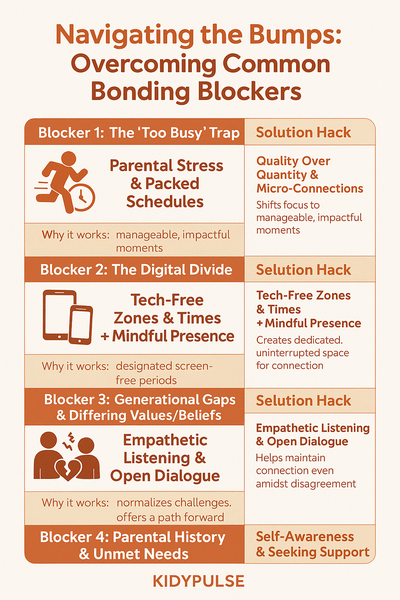
While the desire to bond is strong, everyday life can present obstacles. Recognizing these common challenges and having strategies to navigate them can help maintain and strengthen the parent-child connection. It's important to remember that parent-child conflicts are an inevitable part of family life ; the focus should be on proactive problem-solving rather than feelings of failure.
- Blocker 1: The "Too Busy" Trap (Parental Stress & Packed Schedules): The reality of modern life often involves significant parental stress from work, household chores, and packed schedules. Finding a healthy work-life balance is crucial.
- Solution Hack: Quality over Quantity & Micro-Connections. Emphasize that even short, focused bursts of connection can be powerful. Suggest integrating connection into existing routines, such as during car rides or while cooking together. A dedicated 10 minutes of "special time" can make a significant difference.
- Why it works: This shifts the focus from potentially unattainable ideals of hours of free time to manageable, impactful moments, acknowledging that consistent small efforts are key.
- Blocker 2: The Digital Divide (Technology Distractions for Parents & Kids): Screens can easily interfere with face-to-face interaction, creating a barrier to connection. Navigating digital safety and understanding if screen time is a friend or foe are key.
- Solution Hack: Tech-Free Zones & Times + Mindful Presence. Advocate for designated screen-free periods, such as during mealtimes or for an hour before bed. Encourage parents to model mindful technology use and to be fully present when interacting with their child, putting their own devices away.
- Why it works: This creates dedicated, uninterrupted space for connection and models healthy boundaries with technology for children to learn from.
- Blocker 3: Generational Gaps & Differing Values/Beliefs: As children grow, especially into adolescence, differences in perspectives on lifestyle, career choices, technology, or social norms can emerge, leading to tension.
- Solution Hack: Empathetic Listening & Open Dialogue. Encourage parents to practice active listening to truly understand their child's viewpoint, even if they don't agree. Foster respectful conversations where both sides feel heard without judgment. The aim is to understand, not necessarily to win an argument.
- Why it works: This approach helps maintain the connection even amidst disagreement and teaches children valuable skills in respectful conflict resolution.
- Blocker 4: Parental History & Unmet Needs: Parents who did not experience secure attachment in their own childhoods may find bonding more challenging. Understanding the impact of emotionally immature parents can be a first step.
- Solution Hack: Self-Awareness & Seeking Support. Encourage self-reflection on one's own upbringing and how it might influence current parenting. Gently suggest that if bonding feels consistently difficult, seeking support—such as from parenting groups, family counseling, or therapy—is a sign of strength, not weakness. It's important to remember that parenting skills can be learned.
- Why it works: This normalizes challenges, reduces stigma, and offers a constructive path forward, emphasizing that it's okay to seek help to build these vital skills.
Managing parental stress is also crucial, as an overwhelmed parent will struggle to be emotionally available. Taking care of one's own well-being is not selfish but essential for being able to connect effectively. Obstacles and solutions also change as children age, requiring ongoing adaptation from parents. What blocks connection with a toddler will differ from challenges with a teenager, underscoring that parenting is a dynamic process. For more ideas on adapting, consider looking into new parenting trends or even how AI and tech are transforming childcare.
Your Journey to a Deeper Connection: Small Hacks, Big Impact
The journey to an unbreakable bond with a child is not about grand, infrequent gestures, but is paved with countless small moments of connection – a shared laugh, a listening ear, a comforting hug. These consistent accumulations of loving, responsive interactions are what truly build strength and security in the parent-child relationship. Remember to lead by example in your interactions.
Parents are the most important people in their child's life. Every effort made to connect, even if imperfect, makes a profound difference. There is no such thing as a perfect parent ; the aim is consistent effort and "good enough" parenting, focusing on the overall pattern of care and the willingness to repair miscues when they inevitably happen.
It is not necessary to implement every strategy at once. Perhaps choose one "hack" from this guide that resonates with the family's current needs and try implementing it this week. Focus on progress, not perfection. For more ideas and support, explore our main blog page or check out our nutrition tips and healthy recipes.
The rewards of this investment are immeasurable: a child who feels deeply loved, secure, and understood, equipped with the emotional foundation to thrive throughout their life. Above all, enjoy being with the child, make the most of the time together, and know that parental love and presence go a long way in helping them flourish. This journey of connection not only benefits the child but also brings immense joy and fulfillment to the parent, deepening the sense of belonging for everyone in the family. Learn more about us and our mission to support parents. If you have questions, our FAQ might help.
FAQs About Parenting Hacks: Building Strong Bonds with Your Children
- Question:
Why is building a strong parent-child bond important? - Answer:
A strong parent-child bond creates a foundation for emotional security, trust, and open communication. It helps children develop higher self-esteem, better social skills, and stronger emotional resilience throughout life. - Question:
What are simple ways to strengthen my bond with my child daily? - Answer:
Spending quality time together, engaging in active listening, showing affection, and participating in shared activities like storytelling, cooking, or playing games can significantly strengthen the parent-child connection. - Question:
How does communication impact the parent-child relationship? - Answer:
Open and non-judgmental communication allows children to express their feelings freely, fostering trust and emotional intelligence. Encouraging conversations and validating their emotions help build stronger connections. - Question:
Can busy parents still build strong bonds with their children? - Answer:
Yes! Even small moments like eating meals together, bedtime talks, or short play sessions can strengthen bonds. Being present and engaged, even for short periods, matters more than the duration of time spent. - Question:
How does positive reinforcement help in parenting? - Answer:
Positive reinforcement, such as praising efforts, encouraging achievements, and recognizing good behavior, helps children feel valued and motivated, fostering a deeper emotional connection with parents. - Question:
What role does play have in strengthening the parent-child bond? - Answer:
Play is an essential tool for connection, teaching children social skills, cooperation, and problem-solving while strengthening trust and emotional intimacy between parent and child. - Question:
How can KidyPulse NutriAI support parents in building strong bonds with their children? - Answer:
KidyPulse NutriAI provides personalized parenting tips, emotional intelligence-building activities, and expert guidance to help parents foster meaningful connections with their children.
Sources used in this blog :
Attachment and child development - Mentally Healthy Schools
Fostering Healthy Parent-Child Relationships - M1 Psychology
The Benefits of Positive Parenting | Apple Montessori Schools
Disciplining Kids with Trust and Respect | Johns Hopkins Medicine
10 Essential Guidelines for Teen Discipline: Building Respect and Responsibility
Positive Discipline: Understanding the why of Challenging Behaviour
Positive Discipline Techniques to Reinforce Good Behavior - Children's Discovery Center
The Lifelong Impact of Strong Parent-Child Bonds - The Big Red Barn
Discipline and children | Better Health Channel
The Power of Positive Parenting | Patient and Family Education | UC ...
Introduction to children's attachment - Children's Attachment - NCBI ...
Connect With Your School Age Child 6 to 12 Years Old

Comments
No comments yet. Be the first to leave a comment!